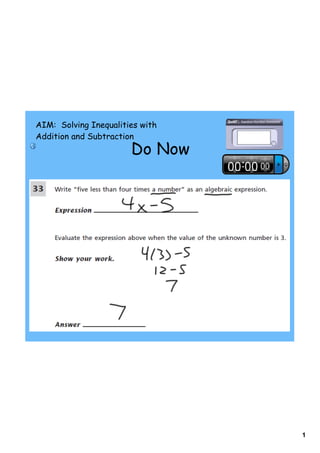
Solving Inequalities with Addition and Subtraction
- 1. AIM: Solving Inequalities with Addition and Subtraction Do Now 1
- 2. Weekly Quiz #3 Evaluate the following using the order of operations. [2 points] 1.) -9 ÷ (-3) 2 - 16 2.) -5(-4 + 2 5)2 Solve and check the following equations. [6 points] 3.) x - 5 = -3 4.) -36 = 4x 5.) -9x + 27 = -36 x 6.) - 15 = -5 2 2
- 3. 3
- 4. 4
- 5. 5
- 6. Anticipatory Set: Explain the differences in the following two word problems. 1. Eddie has $10. How much 2. Allison needs at least $16 more money does he need to dollars to buy a shirt. How much buy a shirt that costs $16? more money does she need if she already has $10? 6
- 7. Anticipatory Set: Explain the differences in the following two word problems. 1. Eddie has $10. How much 2. Allison needs at least $16 more money does he need to dollars to buy a shirt. How much buy a shirt that costs $16? more money does she need if she already has $10? x + 10 = 16 7
- 8. Anticipatory Set: Explain the differences in the following two word problems. 1. Eddie has $10. How much 2. Allison needs at least $16 more money does he need to dollars to buy a shirt. How much buy a shirt that costs $16? more money does she need if she already has $10? x + 10 = 16 x + 10 ≥ 16 8
- 9. Anticipatory Set: Explain the differences in the following two word problems. 1. Eddie has $10. How much 2. Allison needs at least $16 more money does he need to dollars to buy a shirt. How much buy a shirt that costs $16? more money does she need if she already has $10? x + 10 = 16 x + 10 ≥ 16 -10 -10 -10 -10 9
- 10. Anticipatory Set: Explain the differences in the following two word problems. 1. Eddie has $10. How much 2. Allison needs at least $16 more money does he need to dollars to buy a shirt. How much buy a shirt that costs $16? more money does she need if she already has $10? x + 10 = 16 x + 10 ≥ 16 -10 -10 -10 -10 x=6 x≥6 10
- 11. Anticipatory Set: Explain the differences in the following two word problems. 1. Eddie has $10. How much 2. Allison needs at least $16 more money does he need to dollars to buy a shirt. How much buy a shirt that costs $16? more money does she need if she already has $10? x + 10 = 16 x + 10 ≥ 16 -10 -10 -10 -10 x=6 x≥6 11
- 12. Think-Pair-Share Activity A.) x + 4 > 2 12
- 13. B.) x - 5 ≤ -3 C.) 2 ≥ m + 2 13
- 14. D.) -15 < x - 7 14
- 15. F.) -5 > x - 8 15
- 16. Extra Practice More Extra Practice 16
- 17. BEFORE YOU LEAVE An airline lets you check no more than 65 pounds of luggage. One suitcase weighs 37lbs. How much can another suitcase weigh? 17
- 18. Mr. Tjersland's Math 7 Homework: Pages 580-581 #8-13 all, 20, 21, 41 18
- 19. AIM: Solving Inequalities with Addition and Subtraction A.) x + 4 > 2 D.) -15 < x - 7 19
- 20. Attachments Honors Cumulative Review Sheet 4.doc